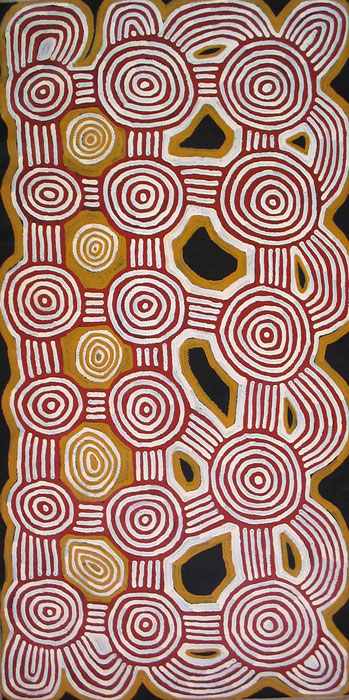Ronnie Tjampitjinpa: Tingari Cycle
ADG: 1392
DescriptionStory of Painting - Tingari Cycle
During the creation era, the Tingari Ancestors gathered at a series of sites for Initiation Ceremonies. They travelled across the country, performing rituals at specific sites, creating the natural features of the landscape. These creation stories and rituals are still portrayed in song cycles, paintings and ceremonies, and are part of the continuous teaching to the next generation.
In painting Tingari stories, the artist is retelling the Song Cycle associated with the artist's many ancestral dreaming sites, and the locations of these significant natural sites in the Gibson Desert.
Ronnie TJAMPITJINPA - Biography
Born c. 1943
Language Pintupi
Community Kintore (Walungurru)
Country Redbank (Ininti)
Region Western Desert
Stories Water Dreaming, BushFire Dreaming, Tingari Cycle, Maliera (Initiation Ceremonies)
Acclaimed as one of the most important Western Desert artists painting today, Ronnie Tjampitjinpa belongs to the esteemed original group of ‘Painting Men’ who commenced painting in the newly established 1960s township of Papunya. Ronnie is one of the few surviving original Papunya Tula shareholders, and is one of Papunya Tula’s major artists.
The child of Minpuru Tjangala and Yahintu Nungurrayi, Ronnie was born in 1943, near Muyinnga, about 40 km. west of Kintore. His younger brother is Smithy Zimron Tjampitjinpa and his sister is Yuyuya Nampitjinpa. The family lived a traditional life in Pintupi territory west of the Kintore Ranges and in the area around Lake Mackay. After prolonged droughts in the 1950s, with a scarcity of food and water, Ronnie’s family moved, first to Haasts Bluff and Yuendumu and then rejoined relatives at Papunya, where Ronnie was employed as a fencer. Ronnie has connections to the Water Dreaming site of Kalipinypa, as it is the place where his grandfather died.
Ronnie’s paintings reflect the characteristic Pintupi style of lines and circles, simple yet bold. His paintings tell of the Western Desert landscape and of Men’s Ceremony paintings, using the four ochre colours of red, yellow, black and white, although Ronnie occasionally experiments by mixing the four basic colours in a repetition of ceremonial forms. His paintings show masterly skill with his deft, sure and carefully controlled works, and are often painted while he sings the stories of his Ancestral country. His paintings are highly collectable
Ronnie moved back to Kintore (Walungurru) country in 1983, and established his principal home site (outstation) close to Kintore at Ininti (Redbank). At one time Ronnie was Chairman of the Kintore Outstation Council, and in 2004 he was elected Chairman of Papunya Tula Artists.
Many solo exhibitions of Ronnie’s paintings have been held and his paintings are held in the collections of a large number of public galleries.
Collections
Aboriginal Art Museum, The Netherlands
Araluen Arts Centre, Alice Springs, NT
Artbank, Sydney, NSW
Art Gallery of New South Wales, Sydney, NSW
Art Gallery of South Australia, Adelaide, SA
Art Gallery of Western Australia, Perth, WA
Campbelltown City Art Gallery, Sydney, NSW
Darwin Supreme Court, Darwin, NT
Donald Kahn collection, Lowe Art Museum, University of Miami, USA
Gabrielle Pizzi Collection, Melbourne, VIC
Musee National des Africans et Oceaniens, (Quai Branly) Paris, France
Museum and Art Gallery of the Northern Territory, Darwin, NT
Muséum de Lyon, France
National Gallery of Australia, Canberra, ACT
National Gallery of Victoria, Melbourne, VIC
Riddoch Art Gallery, Mount Gambier, SA
The Holmes a Court Collection, Perth, WA
Awards
1995 Highly Commended. Recognition at The 20th Annual Fremantle Print Award
1995 Fremantle Arts Centre, WA
1988 Alice Art Prize, Alice Springs, NT
Ranking - Most Important Australian Indigenous Artists (both living and deceased)
2011 Ranked 13/100

